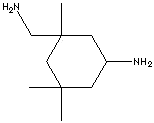|
ISOPHORONE DIAMINE
|
||
|
PRODUCT IDENTIFICATION |
||
| CAS NO | 2855-13-2 |
|
| EINECS NO. | 220-666-8 | |
| FORMULA | C10H22N2 | |
| MOL WT. | 170.30 | |
| H.S. CODE | 2933.29 | |
|
TOXICITY |
Oral rat LD50: 1030 mg/kg | |
| SYNONYMS | 5-Amino-1,3,3-Trimethyl Cyclohexanemethanamine; | |
| 1-Amino-3-aminomethyl-3,5,5-trimethyl cyclohexane; 3-Aminomethyl-3,5,5-trimethyl cyclohexylamine; 3-Aminomethyl-3,5,5-trimethylcyclohexylamin (German); 3-Aminometil-3,5,5-trimetilciclohexilamina (Spanish); 3-Aminométhyl-3,5,5-triméthyl cyclohexylamine (French); | ||
|
SMILES |
|
|
|
CLASSIFICATION |
|
|
|
PHYSICAL AND CHEMICAL PROPERTIES |
||
| PHYSICAL STATE | Clear liquid | |
| MELTING POINT | 10 C | |
| BOILING POINT | 245 - 247 C | |
| SPECIFIC GRAVITY | 0.920 - 0.925 | |
| SOLUBILITY IN WATER | Miscible | |
| pH |
11.5 - 12.5 (10% Sol.) |
|
| VAPOR DENSITY | 5.9 | |
| AUTOIGNITION |
380 C |
|
| NFPA RATINGS | Health: 3; Flammability: 1; Reactivity: 0 | |
|
REFRACTIVE INDEX |
1.4877 |
|
| FLASH POINT |
112 C |
|
| STABILITY | Stable under ordinary conditions. Hygroscopic. | |
|
APPLICATIONS |
||
|
Diamines are compounds which contain two amino groups. Both aliphatic
(linear or branched from short C-2 chain to fatty length ) and aromatic diamines
are used as a monomer to form copolymers like nylons, polyesters and
polyurethanes for characteristic properties. They can form a protein-like
structure at both ends of each monomer. The chain length characteristics with
recurring amide groups provide a variety physical properties and are further
processed into various applications including plastics, oil-modified and
moisture-area types of urethane coatings, polyamides for printing inks, dimer
acids, textiles, lubricant additive as scale and corrosion inhibitor, epoxy
curing agent, isocyanates, water treatment chemicals, biocides, and
pharmaceutical intermediates. Cycloaliphatic diamines are used in urethane and epoxy coatings for light-stable, weather-resistant properties. It is used in water proofing and paving concreting. It is used in manufacturing diisocyanates and polyamides. Common cycloaliphatic diamines include isophorone diamine, 1,2-diaminocyclohexane, 1,4-bis(aminocyclohexyl)methane, 1,3-bis(aminomethyl)cyclohexane, bis(aminomethyl)norbornane. They are versatile intermediate to produce leather, rubber products, plastics, pesticides, dyes, and photo sensitive polymers. It is used in manufacturing diisocyanates and polyamides. Aliphatic diamines are the most common epoxy curing agent. Members include:
|
||
| SALES SPECIFICATION | ||
|
APPEARANCE |
Clear liquid | |
|
ASSAY |
99.5% min |
|
|
AMINE VALUE |
640 mg/kg |
|
|
COLOR, APHA |
20 max |
|
| TRANSPORTATION | ||
| PACKING | 200kgs in drum | |
| HAZARD CLASS | 8 (Packing group:III) | |
| UN NO. | 2289 | |
| OTHER INFORMATION | ||
|
Hazard
Symbols: C, Risk Phrases: 21/22-34-43-52/53, Safety Phrases: 26-36/37/39-45-61
|
||
